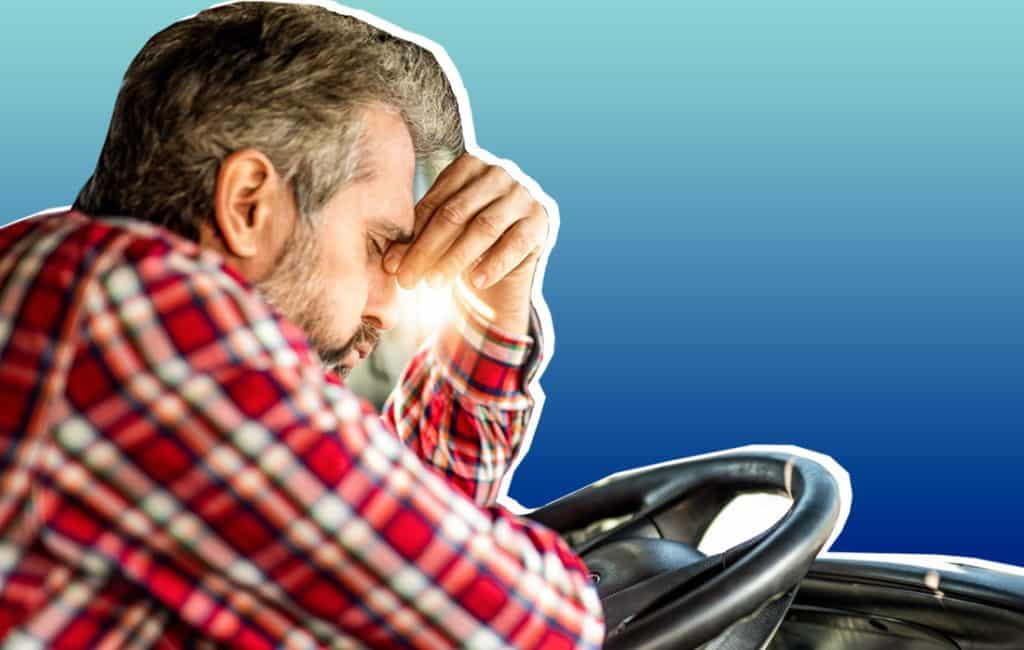
Driving can get dull for some, but operating a huge hunk of metal requires a lot of concentration. So when you hop behind the wheel a bit sleepy, you could be at higher risk of getting into an auto mishap. In fact, about 20 percent of driving incidents are blamed on fatigue. (1)
You may think that has an easy fix – get more sleep! But people with obstructive sleep apnea (OSA) don’t always have that option. Almost 40 million adults in the U.S. have OSA. (2) What’s more, up to 90 percent of people with this disorder haven’t been diagnosed by a healthcare provider. (3)
A new study published in January 2024 found that people with obstructive sleep apnea syndrome (OSAS) used several coping techniques to help them stay awake while they drive. They used them so much more so than the non-sleep apnea group, the researchers suggest providers could even use a Driving Sleepiness Scale to help diagnose OSAS.
“Understanding how individuals with OSA navigate the challenges of driving through effective and safe strategies is paramount for improving overall road safety,” says Dr. Chris Allen, MD, Sleep Medicine Physician and Aeroflow Sleep Sleep Science Advisor
When you have obstructive sleep apnea, your airway closes on and off throughout the night, interrupting your breathing and waking you up. (4) Between fragmented sleep, frequent waking, and low oxygen levels, OSA creates the perfect recipe for daytime sleepiness, says Dr. Paresh D. Patel, MD, a pulmonology and sleep medicine specialist at Houston Methodist Willowbrook Hospital
If you don’t know you have sleep apnea, you can’t get treated. And untreated sleep apnea is associated with a higher rate of traffic accidents, which brings us full circle.
- Sleep apnea: Describes all sleep apnea types, including central and obstructive.
- Obstructive sleep apnea (OSA): Your interrupted breathing is caused by a blockage in your throat while you sleep.
- Obstructive sleep apnea syndrome (OSAS): This study talks exclusively about OSAS, which basically describes OSA that happens all the time and causes symptoms like excessive sleepiness and other health problems. (5)
In this piece, we’ll use sleep apnea, OSA, and OSAS interchangeably, but wanted you to know the difference. Now, back to our regularly scheduled programming…
Strategies to Stay Awake Behind the Wheel
The study included 119 people with untreated sleep apnea and 105 people without OSAS. Each one answered questions about their experiences over the last year, like general sleepiness, feeling sleepy while driving, and their coping techniques.
Curious about these techniques? Here are the various strategies participants used to stay awake behind the wheel:
- Stopped for a nap or walk
- Opened the window
- Turned up the radio/stereo
- Stopped to drink tea/coffee
- Splashed face with cold water
- Sang or talked to themselves
- Chewed gum or ate
- Fidgeted
- Changed seat position
Any of these sound familiar? These habits along with all the other questions about sleepiness helped the researchers develop their Driving Sleepiness Scale, or DSS.
Study Results: How Did People with OSA Fare?
Compared to the folks with no sleep apnea, almost a third of the OSAS group used more than three of the strategies above. They also found that people who used four or more sleep-banishing coping techniques reported more sleepiness in general, and were more likely to feel drowsy when driving.
The OSAS group who used over three strategies reported a lot more accidents than those in the group who used three or fewer. Study participants with OSAS also reported a lot more nodding off episodes and near misses on the road. So, what does all this mean for people with sleep apnea, or those who think they might have it?
What Now?
First of all, let’s make sure you’re staying safe. “I would advise [people] not to drive or operate any equipment when drowsy or sleepy as it poses a serious safety risk,” says Patel, who encourages people who find themselves sleepy behind the wheel to find out why. You can talk to your healthcare provider to start that process and get to the bottom of your drowsiness mystery.
The study authors claim that these coping behaviors seen in people with OSAS could point healthcare providers toward a sleep apnea diagnosis. They say it can’t diagnose the condition alone, but could be used along with other tests and questionnaires to keep fewer OSA cases from falling through the cracks.
“By emphasizing the identification of coping mechanisms that prioritize alertness, minimize fatigue, and enhance concentration, the study has the potential to contribute significantly to the development of targeted interventions,” says Allen.
Who knows, maybe in a few years, your provider may ask you about any tricks you use to stay awake behind the wheel as part of your yearly checkup. Until then, be sure to let your provider know if you feel sleepy during the day, especially while you’re driving!
Sources
1. Sprajcer M, Dawson D, Kosmadopoulos A, et al. How Tired is Too Tired to Drive? A Systematic Review Assessing the Use of Prior Sleep Duration to Detect Driving Impairment. NSS. 2023;Volume 15:175-206. doi:10.2147/NSS.S392441
2. Sleep Apnea Statistics and Facts You Should Know. Accessed February 6, 2024. https://www.ncoa.org/adviser/sleep/sleep-apnea-statistics/
3. Santilli M, Manciocchi E, D’Addazio G, et al. Prevalence of Obstructive Sleep Apnea Syndrome: A Single-Center Retrospective Study. International Journal of Environmental Research and Public Health. 2021;18(19):10277. doi:10.3390/ijerph181910277
4. Sleep Apnea – What Is Sleep Apnea? | NHLBI, NIH. Accessed November 20, 2023. https://www.nhlbi.nih.gov/health/sleep-apnea
5. Sleep Apnea Syndrome – StatPearls – NCBI Bookshelf. Accessed February 7, 2024. https://www.ncbi.nlm.nih.gov/books/NBK564431/
6. Dwarakanath A, Palissery V, Ghosh D, Jamson S, Elliott M. An exploratory study evaluating the use of coping strategies while driving in obstructive sleep apnoea syndrome patients and controls. ERJ Open Res. 2024;10(1):00638-02023. doi:10.1183/23120541.00638-2023
Patel M.D., Paresh D. Author interview. February 7, 2024
Allen, M.D., Chris. Author interview. February 2024.



























